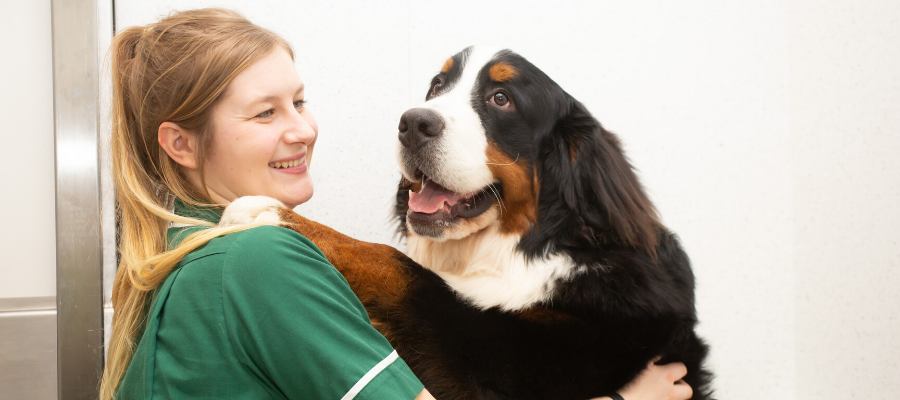What is epilepsy?
Epilepsy is a chronic condition which causes seizures both in dogs and more rarely in cats. It is divided into two categories, idiopathic (no known cause) and symptomatic (has an underlying cause). In most cases it is a lifelong condition which is manageable with medication.
A seizure occurs when there is abnormal electrical activity within the brain, causing involuntary movements and behaviour. These have a sudden onset and are normally short-lived.
Some dog breeds are predisposed to this disorder, for example, golden retrievers, beagles, Labradors, border collies and dachshunds. In cats, there are no specific breeds that are prone to epilepsy.
What are the causes?
Seizures may occur due to an identifiable cause like a toxin, liver disease, kidney disease, low blood sugar level, tumours, brain malformations and inflammation. This is known as ‘symptomatic’ epilepsy. Build-up of toxins from liver or kidney disease is often the case with cats, alongside accidental ingestion of certain drugs.
If there is no underlying cause, then this is known as ‘idiopathic’ or primary epilepsy. In most cases it is presumed that it has been caused by an underlying genetic predisposition.
What to look out for?
- Falling over
- Loss of consciousness
- Foaming at the mouth
- Chewing
- Muscle spasms thrashing and paddling
- Urinating and defecating
- Eyes moving (nystagmus)
- Face twitching
Types of Seizures
Generalised, tonic-clonic or grand mal seizure
This is the most common type of seizure and involves the whole body and both hemispheres of the brain. The animal will often become unconscious and all the muscles of the body contract. They may become stiff, drool or foam at the mouth and lose control of bladder or bowels. Your pet can be unresponsive for between 1-3 minutes after which time the ‘fit’ should pass.
Focal or partial seizure
This is when a small localized part of the brain is affected and can cause the face to twitch, the eye to blink repeatedly and one side of the body to move. These can remain partial or travel to the rest of the brain and turn into a generalised seizure.
Cluster Seizures
This is when a dog or cat experiences multiple seizures in a short period of time, normally within 24 hours. This is an emergency and needs treatment.
Status epilepticus
This happens when your pet experiences multiple seizures but doesn’t regain consciousness in between them, or is when the seizure lasts longer than 5 minutes. This is a life-threatening emergency.
What to do in the event of a seizure
- Stay calm and take children and other pets away from the area.
- Don’t move your pet during a seizure, as you could hurt them or yourself, unless they are in immediate danger.
- Turn the lights off in the room and keep noise to a minimum.
- Clear furniture or objects away from your pet to keep them safe and comfortable.
- Time the length of the seizure, and if possible video it. If it lasts more than five minutes, contact your vet.
- Reassure your pet after they have had a seizure- speak quietly and give them somewhere comfortable to recover.
- Many dogs will be hungry after a seizure, so make sure that there is food and water available. If the seizures are caused by low blood sugar, feeding your dog something sugary like honey can help to bring their glucose levels up quickly.
- If this is the first seizure, call your vet. They may not ask you to come down immediately but will provide you with advice.
How is epilepsy diagnosed?
No single test can confirm that your dog or cat has idiopathic epilepsy. It’s a process of elimination to rule out an underlying condition or a brain malfunction. Diagnosis starts by running multiple tests to rule out other conditions outside of the brain that could be causing the seizures. Blood and urine samples are likely to be collected and tested as part of the investigation into the cause of the seizure. Blood pressure can also be checked, especially in older cats as this can be a sign of organ malfunction. Advanced brain imaging can be done, like an MRI scan (magnetic resonance imaging) to check for a structural brain problem.
How is it treated?
Epilepsy can lead to variations in the severity and frequency of the seizures, from one or two a year to several a week. It is recommended that epilepsy is treated if your pet has experienced more than two seizures in a six-month period. Epilepsy can be controlled with an anti-epileptic drug and sometimes a combination of several medications is needed to achieve adequate seizure control. Occasionally no medication is needed.
The aim is to reduce the seizure frequency by 50% in the first four weeks. Also, the severity of the seizures should reduce.
Call us on 01435 864422 if you think your pet may be showing signs of epilepsy or book a health check via our online booking system.


